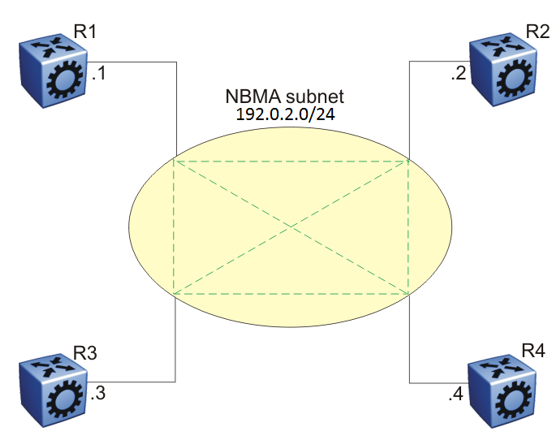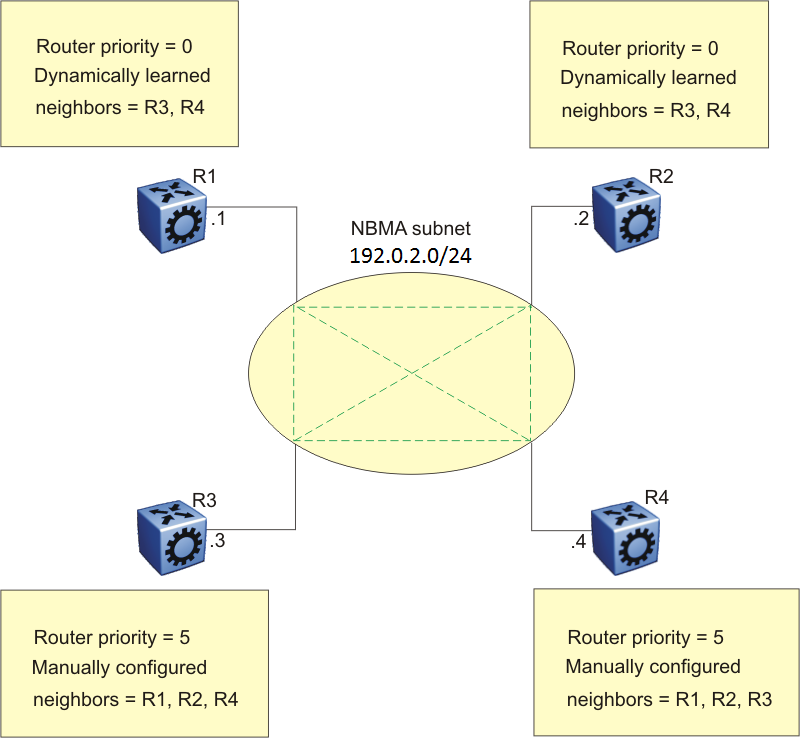OSPF Interfaces
Configure an OSPF interface, or link, on an IP interface. An IP interface can be either a single link (brouter port) or a logical interface configured on a VLAN (multiple ports). The state information associated with the interface is obtained from the underlying lower-level protocols and the routing protocol itself.

Important
To change the interface type of an enabled OSPF interface, you must first disable it, change the type, and then reenable it. For an NBMA interface, you must first delete manually configured neighbors.
OSPF network types allow OSPF-neighboring between routers over various types of network infrastructures. You can configure each interface to support various network types. The following table describes the supported OSPF network interface types:
|
Network interface type |
Description |
|---|---|
|
Broadcast interfaces automatically discover every OSPF router on the network by sending OSPF hello packets to the multicast group AllOSPFRouters (224.0.0.5). Neighboring is automatic and requires no configuration. |
|
|
The NBMA network type models network environments that do not have native Layer 2 broadcast or multicast capabilities, such as Frame Relay and X.25. OSPF hello packets are unicast to manually configured neighbors. |
|
|
A passive interface is an interfacing network in OSPF that does not generate LSAs or form adjacencies. Use a passive interface on an access network or on an interface used for BGP peering. Using passive interfaces limits the amount of CPU cycles required to perform the OSPF routing algorithm. |
|
|
A point-to-point interface is a single connection between two specific points or OSPF routers. Point-to-Point interfaces automatically discover OSPF routers (up to two) on the network by sending OSPF hello packets to the multicast group AllOSPFRouters (224.0.0.5). Neighboring is automatic and requires no configuration. |
Broadcast Interfaces
Broadcast interfaces support many attached routers and can address a single physical message to all attached broadcast routers (sent to AllSPFRouters and AllDRouters).
Broadcast interfaces dynamically discover neighboring routers using the OSPF Hello protocol. Each pair of routers on a broadcast network, such as an Ethernet, communicate directly.
Non-Broadcast Multiple Access Interfaces
An NBMA network interconnects multiple devices through point-to-point links. NBMA does not use broadcast and multicast data transmission.
NBMA interfaces support many routers, but cannot broadcast. NBMA networks perform the following activities:
Statically establish OSPF neighbor relationships.
You must establish neighbor relationships because hub-and-spoke Wide Area Network (WAN) topologies do not support any-to-any broadcasting.
Control meshed WAN connections.
In contrast to a broadcast network, where some OSPF protocol packets are multicast (sent to AllSPFRouters and AllDRouters), OSPF packets on an NBMA interface are replicated and sent in turn to each neighboring router as unicast. NBMA networks drop all OSPF packets with destination address AllSPFRouters and AllDRouters.
The following figure shows an example of four routers attached to an NBMA subnet. The NBMA segment uses a single IP subnet and each router uses an IP address within the subnet.

NBMA Interface Operations and Parameters
OSPF treats an NBMA network much like it treats a broadcast network. Because many routers attach to the network, the Hello protocol elects a designated router (DR) to generate the network link-state advertisements.
Because the NBMA network does not broadcast, you must manually configure neighbors for each router eligible to become DR (those networks with a positive, nonzero router priority value). You must also configure a poll interval for the network.
NBMA interfaces with a positive, nonzero router priority can become DR for the NBMA network and contain a list of all attached routers, or neighbors. This neighbors list includes each neighbor IP address and router priority.
The router uses neighbor information both during and after the DR election process. After an interface to a nonbroadcast network with a nonzero priority initializes, and before the Hello protocol elects a DR, the router sends hello packets only to those neighbors eligible to become DR. After the Hello protocol elects a DR, it forms adjacencies only with its configured neighbors and drops all packets from other sources. This neighbor configuration also notifies the router of the expected hello behavior of each neighbor.
If a router eligible to become the DR receives a hello packet from a neighbor that shows a different priority from that which is already configured for this neighbor, the DR changes the configured priority to match the dynamically learned priority.
Configure an NBMA interface with a poll interval. The poll interval designates the interval at which the router sends hello packets to inactive neighboring routers. The router typically sends hello packets at the Hello interval, for example, every 10 seconds. If a neighboring router becomes inactive, or if the router does not receive hello packets for the established RouterDeadInterval period, the router sends hello packets at the specified poll interval, for example, every 120 seconds.
You must configure a neighbors list for the DR to allow an NBMA network to send hello packets. If the router is eligible to become a DR, it periodically sends hello packets to all neighbors that are also eligible. The effect of this action is that two eligible routers always exchange hello packets, which is necessary for the correct DR election. You can minimize the number of hello packets by minimizing the number of eligible routers on a nonbroadcast network.
After the Hello protocol elects a DR, it sends hello packets to all manually configured neighbors to synchronize their link-state databases, establish itself as the DR, and identify the backup designated router (BDR).
If a router is not eligible to become DR, it periodically sends hello packets to both the DR and the BDR. The router also sends a hello packet in reply to a hello packet received from an eligible neighbor (other than the current DR and BDR). This process establishes an initial bidirectional relationship with a potential DR.
When a router sends hello packets to a neighbor, the neighbor state determines the interval between hello packets. If the neighbor is in the down state, the router sends hello packets at the designated poll interval, for example, every 120 seconds. Otherwise, the router sends hello packets at the designated hello interval, for example, every 10 seconds.
OSPF and NBMA Example: Adjacency Formation
In an NBMA network, as in a broadcast network, all routers become adjacent to the DR and the BDR. The adjacencies form after you assign the router priorities, configure the neighbors, and the Hello protocol elects the network DR.
The following figure shows an NBMA subnet with router priorities and manually configured neighbors.

Because R1 and R2 have a router priority of 0, they are not eligible to become the DR. Also, R1 and R2 do not require configuration of a neighbors list; R1 and R2 discover neighbors dynamically through the Hello protocol.
R3 and R4 both have a positive, nonzero priority and are eligible to become the DR. Manually configure neighbor lists on R3 and R4.
To create this NBMA network, configure the following parameters:
On each router: NBMA interface type, poll interval, router priority
On R3: R1, R2, and R4 as neighbors
On R4: R1, R2, and R3 as neighbors
If all routers start at the same time, the routers perform the following steps:
R3 and R4 send each other a hello packet to elect a DR.
The Hello protocol elects R3 as the DR, and R4 as the BDR.
R3 (DR) and R4 (BDR) send hello packets to all other routers on the NBMA subnet to synchronize their link-state databases and establish themselves as DR and BDR.
R1 and R2 reply to R3 and R4.
R3 and R4 each form three adjacencies (one with each router on the NBMA subnet).
R1 and R2 each form two adjacencies (one with the DR and one with the BDR).
Passive Interfaces
Use a passive interface to enable an interface to advertise into an OSPF domain while limiting its adjacencies.
After you change the interface type to passive, the router advertises the interface into the OSPF domain as an internal stub network with the following behaviors:
Does not send hello packets to the OSPF domain.
Does not receive hello packets from the OSPF domain.
Does not form adjacencies in the OSPF domain.
If you configure an interface as passive, the router advertises it as an OSPF internal route. If the interface is not a passive interface, to advertise a network into OSPF and not form OSPF adjacencies, you must configure the interface as nonOSPF, and the router must redistribute the local network as an autonomous system external (ASE) LSA.
Point-to-Point Interfaces
A point-to-point interface supports a single OSPF router on either end of the link and can address a single physical message between the two routers (sent to AllSPFRouters). A point-to-point link does not elect a designated router (DR) or a backup designated router (BDR).

Note
Unnumbered point-to-point interfaces are not supported.

